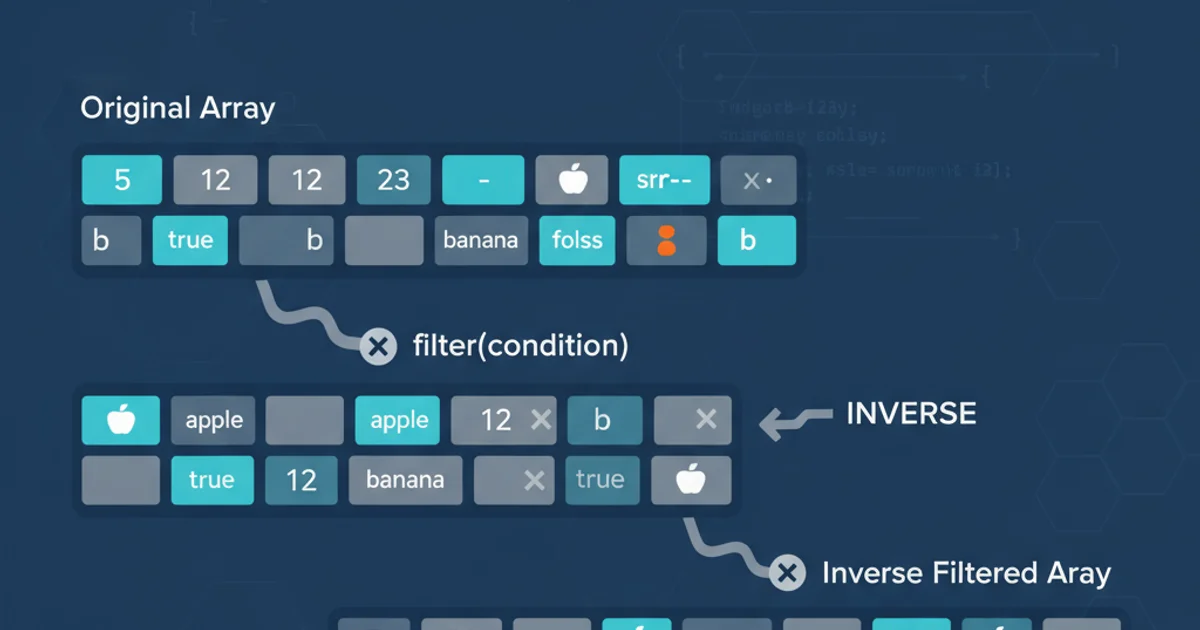Inverse of [].filter in JS?
Categories:
The Inverse of Array.prototype.filter() in JavaScript

Explore various methods to achieve the opposite of JavaScript's filter() method, effectively selecting elements that do not meet a specified condition.
The Array.prototype.filter() method in JavaScript creates a new array with all elements that pass the test implemented by the provided function. But what if you need the elements that fail the test? This article delves into several techniques to achieve the inverse of filter(), providing practical examples and discussing their nuances.
Understanding Array.prototype.filter()
Before we dive into the inverse, let's quickly recap how filter() works. It iterates over each element in an array and executes a callback function. If the callback returns true, the element is included in the new array; otherwise, it's excluded. The original array remains unchanged.
const numbers = [1, 2, 3, 4, 5, 6];
// Filter for even numbers
const evenNumbers = numbers.filter(num => num % 2 === 0);
console.log(evenNumbers); // Output: [2, 4, 6]
Basic usage of Array.prototype.filter()
Method 1: Negating the Predicate
The most straightforward way to get the inverse of filter() is to simply negate the condition (predicate) within the callback function. If filter() includes elements where the condition is true, then negating the condition will include elements where the original condition would have been false.
const numbers = [1, 2, 3, 4, 5, 6];
// Inverse filter: get odd numbers by negating the even number condition
const oddNumbers = numbers.filter(num => !(num % 2 === 0));
// Alternatively, a more direct condition for odd numbers
// const oddNumbers = numbers.filter(num => num % 2 !== 0);
console.log(oddNumbers); // Output: [1, 3, 5]
Negating the predicate to achieve the inverse filter
num % 2 !== 0) rather than explicitly negating the original one.Method 2: Using reduce() for a Custom 'reject' Function
While filter() is designed for inclusion, you can create a custom 'reject' function using reduce() that explicitly collects elements that do not satisfy a condition. This approach offers more control and can be useful if you prefer a more declarative 'reject' semantic.
function reject(arr, predicate) {
return arr.reduce((acc, item) => {
if (!predicate(item)) {
acc.push(item);
}
return acc;
}, []);
}
const numbers = [1, 2, 3, 4, 5, 6];
// Reject even numbers (i.e., get odd numbers)
const oddNumbers = reject(numbers, num => num % 2 === 0);
console.log(oddNumbers); // Output: [1, 3, 5]
Implementing a custom 'reject' function using reduce()
flowchart TD
A[Start with Array] --> B{Iterate with reduce()};
B --> C{Apply Predicate to Element};
C -->|Predicate is FALSE| D[Add Element to Accumulator];
C -->|Predicate is TRUE| E[Skip Element];
D --> B;
E --> B;
B --> F[Return Accumulator (New Array)];Workflow of a custom 'reject' function using reduce()
Method 3: Combining filter() with a Helper Function
For more complex scenarios or to maintain a consistent API, you might define a helper function that takes a predicate and returns its negated version. This can make your code cleaner, especially if you reuse predicates.
const negate = predicate => (...args) => !predicate(...args);
const isEven = num => num % 2 === 0;
const isOdd = negate(isEven);
const numbers = [1, 2, 3, 4, 5, 6];
const oddNumbers = numbers.filter(isOdd);
console.log(oddNumbers); // Output: [1, 3, 5]
Using a negate helper function with filter()
negate functions can be elegant, be mindful of their impact on debugging. Stack traces might become slightly more complex if you're chaining many higher-order functions.Performance Considerations
For most common use cases with reasonably sized arrays, the performance difference between these methods will be negligible. Negating the predicate directly within filter() is generally the most performant as it avoids the overhead of an additional function call or the more complex reduce() operation. However, readability and maintainability should often take precedence over micro-optimizations unless profiling indicates a bottleneck.
In summary, the 'inverse' of Array.prototype.filter() is most commonly achieved by simply negating the condition within the filter() callback. For more advanced patterns or semantic clarity, custom reject functions or predicate negators can be employed.